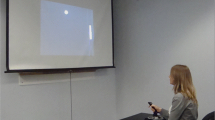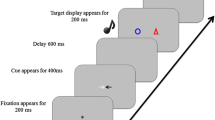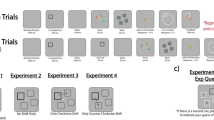Abstract
A critical question for theories of spatial vision concerns the nature of the inputs to perception. The action-specific account asserts that information related to action, specifically a perceiver’s ability to perform the intended action, is one of these sources of information. This claim challenges assumptions about the mind in general and perception in particular, and not surprisingly, has been met with much resistance. Alternative explanations include that these effects are due to response bias, rather than genuine differences in perception. Using a paradigm in which ease to block a ball impacts estimated speed of the ball, participants were given explicit feedback about their perceptual judgements to test the response bias alternative. Despite the feedback, the action-specific effect still persisted, thus ruling out a response-bias interpretation. Coupled with other research ruling out additional alternative explanations, the current findings offer an important step towards the claim that a person’s ability to act truly influences spatial perception.









Similar content being viewed by others
Notes
An alternative method would be to look at the just-noticeable differences (JNDs). However, JNDs cannot be computed for participants whose data showed quasi-complete separation, so proportion correct was considered instead.
An exception to this is that post-events can influence perception, which is known as postdiction. Thus, it is possible that trial outcome could affect perceived ball speed. We are unaware of any techniques to separate postdictive explanations from judgment-based explanations and thus take the more conservative view that any effects of trial outcome are due to response biases or judgment-based effects rather than being genuinely perceptual. An argument that the effect of trial outcome is perceptual would be consistent with the action-specific account of perception (for extended discussion on this issue, see Witt, Tenhundfeld, & Bielak, 2017).
References
Aberg, K. C., Tartaglia, E. M., & Herzog, M. H. (2009). Perceptual learning with Chevrons requires a minimal number of trials, transfers to untrained directions, but does not require sleep. Vision Research, 49, 2087–2094.
Asch, S. E. (1955). Opinions and Social Pressure. Scientific American, 193(5), 31–35.
Biederman, I., & Shiffrar, M. M. (1987). Sexing day-old chicks: a case study and expert systems analysis of a difficult perceptual-learning task. Journal of Experimental Psychology Learning Memory and Cognition, 13, 640–645.
Choe, C. S., Welch, R. B., Gilford, R. M., & Joula, J. F. (1975). The “ventriloquist effect”: visual dominance or response bias? Perception and Psychophysics, 18(1), 55–60.
Durgin, F. H., Baird, J. A., Greenburg, M., Russell, R., Shaughnessy, K., & Waymouth, S. (2009). Who is being deceived? The experimental demands of wearing a backpack. Psychonomic Bulletin and Review, 16(5), 964–969. doi:10.3758/PBR.16.5.964.
Firestone, C., & Scholl, B. J. (2016). Cognition does not affect perception: evaluating the evidence for ‘top-down’ effects. Behavioral and Brain Sciences, 39, e229. doi:10.1017/S0140525X15000965.
Foley, J. M. (1977). Effect of distance information and range on two indices of visually perceived distance. Perception, 6(4), 449–460.
Gogel, W. C. (1990). A theory of phenomenal geometry and its applications. Perception and Psychophysics, 48(2), 105–123.
Gray, R. (2013). Being selective at the plate: processing dependence between perceptual variables relates to hitting goals and performance. Journal of Experimental Psychology Human Perception and Performance, 39(4), 1124–1142.
Grove, P. M., Ashton, J., Kawachi, Y., & Sakurai, K. (2012). Auditory transients do not affect visual sensitivity in discriminating between objective streaming and bouncing events. Journal of Vision, 12(8), 1–11.
Hommel, B., Musseler, J., Aschersleben, G., & Prinz, W. (2001). The theory of event coding (TEC): a framework for perception and action planning. Behavioral and Brain Sciences, 24, 849–937.
Karni, A., Tanne, D., Rubenstein, B. S., Askenasy, J. J., & Sagi, D. (1994). Dependence on REM sleep of overnight improvement of a perceptual skill. Science, 265(5172), 679–682.
Kirsch, W., & Kunde, W. (2014). Impact of planned movement direction on judgments of visual locations. Psychological Research Psychologische Forschung, 78, 705–720.
Lee, Y., Lee, S., Carello, C., & Turvey, M. T. (2012). An archer’s perceived form scales the “hitableness” of archery targets. Journal of Experimental Psychology Human Perception and Performance, 38(5), 1125–1131.
Lindemann, O., & Bekkering, H. (2009). Object manipulation and motion perception: evidence of an influence of action planning on visual processing. Journal of Experimental Psychology Human Perception and Performance, 35(4), 1062–1071.
Lippert, M., Logothetis, N. K., & Kayser, C. (2007). Improvement of visual contrast detection by a simultaneous sound. Brain Research, 1173, 102–109.
Loomis, J. M. (2016). Proposed applications of research on action-specific effects are premature. Journal of Applied Research in Memory and Cognition, 5(1), 77–79.
Loomis, J. M., & Philbeck, J. W. (2008). Measuring perception with spatial updating and action. In R. L. Klatzky, M. Behrmann & B. MacWhinney (Eds.), Embodiment, ego-space, and action (pp. 1–44). Mahwah: Erlbaum.
Musseler, J., & Hommel, B. (1997). Blindness to response-compatible stimuli. Journal of Experimental Psychology Human Perception and Performance, 23(3), 861–872.
Odgaard, E. C., Arieh, Y., & Marks, L. E. (2003). Cross-modal enhancement of perceived brightness: sensory interaction versus response bias. Perception and Psychophysics, 65, 123–132.
Philbeck, J. W., & Witt, J. K. (2015). Action-specific influences on perception and post-perceptual processes: present controversies and future directions. Psychological Bulletin, 141(6), 1120–1144. doi:10.1037/a0039738.
Proffitt, D. R. (2008). An action-specific approach to spatial perception. In R. L. Klatzky, B. MacWhinney & M. Behrmann (Eds.), Embodiment, ego-space, and action (pp. 179–202). New York: Psychology Press.
Proffitt, D. R., & Linkenauger, S. A. (2013). Perception viewed as a phenotypic expression. In W. Prinz, M. Beisert & A. Herwig (Eds.), Action science: Foundations of an emerging discipline (pp. 171–198). Cambridge: MIT Press.
Rosenthal, O., Shimojo, S., & Shams, L. (2009). Sound-induced flash illusion is resistant to feedback training. Brian Topography, 21, 185–192.
Taylor, J. E. T., Witt, J. K., & Sugovic, M. (2011). When walls are no longer barriers: perception of wall height in parkour. Perception, 40(6), 757–760. doi:10.1068/P6855.
van der Kamp, J., Withagen, R., & de Witt, M. M. (2013). Cultural and learning differences in the Judd illusion. Attention Perception and Psychophysics, 75, 1027–1038.
Wesp, R., & Gasper, J. (2012). Is size misperception of targets simply justification for poor performance? Perception, 41(8), 994–996. doi:10.1068/p7281.
Wilson, T. D., Reinhard, D. A., Westgate, E. C., Gilbert, D. T., Ellerbeck, N., Hahn, C., & Shaked, A. (2014). Just think: the challenges of the disengaged mind. Science, 345(July 4), 75–77.
Witt, J. K. (2011). Action’s Effect on Perception. Current Directions in Psychological Science, 20(3), 201–206. doi:10.1177/0963721411408770.
Witt, J. K. (2016a). Action potential influences spatial perception: evidence for genuine top-down effects on perception. Psychonomic Bulletin and Review.
Witt, J. K. (2016b). Perception and action. In J. T. Wixted (Ed.), Stevens’ handbook of experimental psychology and cognitive neuroscience, fourth edition (Fourth ed., Vol. 2). New York: Wiley.
Witt, J. K. (2016c). Spatial biases from action. In T. Hubbard (Ed.), Spatial biases. Cambridge: Cambridge University Press.
Witt, J. K., Linkenauger, S. A., Bakdash, J. Z., & Proffitt, D. R. (2008). Putting to a bigger hole: golf performance relates to perceived size. Psychonomic Bulletin and Review, 15(3), 581–585. doi:10.3758/15.3.581.
Witt, J. K., & Proffitt, D. R. (2005). See the ball, hit the ball - Apparent ball size is correlated with batting average. Psychological Science, 16(12), 937–938. doi:10.1111/j.1467-9280.2005.01640.x.
Witt, J. K., Schuck, D. M., & Taylor, J. E. T. (2011). Action-specific effects underwater. Perception, 40(5), 530–537. doi:10.1068/P6910.
Witt, J. K., & Sugovic, M. (2010). Performance and ease influence perceived speed. Perception, 39(10), 1341–1353. doi:10.1068/P6699.
Witt, J. K., & Sugovic, M. (2012). Does ease to block a ball affect perceived ball speed? Examination of alternative hypotheses. Journal of Experimental Psychology Human Perception and Performance, 38(5), 1202–1214. doi:10.1037/a0026512.
Witt, J. K., & Sugovic, M. (2013a). Catching ease influences perceived speed: evidence for action-specific effects from action-based measures. Psychonomic Bulletin and Review, 20, 1364–1370.
Witt, J. K., & Sugovic, M. (2013b). Response bias cannot explain action-specific effects: evidence from compliant and non-compliant participants. Perception, 42, 138–152.
Witt, J. K., Sugovic, M., & Dodd, M. D. (2016). Action-specific perception of speed is independent of attention. Attention Perception and Psychophysics, 78(3), 880–890. doi:10.3758/s13414-015-1047-6.
Witt, J. K., Sugovic, M., & Taylor, J. E. T. (2012). Action-specific effects in a social context: others’ abilities influence perceived speed. Journal of Experimental Psychology Human Perception and Performance, 38(3), 715–725. doi:10.1037/a0026261.
Witt, J. K., Sugovic, M., Tenhundfeld, N. T., & King, Z. R. (2016). An action-specific effect on perception that avoids all pitfalls. Behavioral and Brain Sciences, 39, e261. doi:10.1017/S0140525X15002563.
Witt, J. K., Tenhundfeld, N. T., & Bielak, A. A. M. (2017). Dissociating perception from judgment in the action-specific effect of blocking ease on perceived speed. Attention Perception and Psychophysics, 79(1), 283–297.
Woods, A. J., Philbeck, J. W., & Danoff, J. V. (2009). The various perceptions of distance: an alternative view of how effort affects distance judgments. Journal of Experimental Psychology Human Perception and Performance, 35(4), 1104–1117. doi:10.1037/a0013622.
Acknowledgements
We thank Lew Harvey for his help analyzing the data. This work was supported by Grants from the National Science Foundation to JKW (BCS-1348916 and BCS-1632222).
Author information
Authors and Affiliations
Corresponding author
Ethics declarations
All procedures were in accordance with the ethical standards of the institutional research committee and with the 1964 Helsinki declaration and its later amendments or comparable ethical standards. Informed consent was obtained from all individual participants included in the study.
Conflict of interest
The authors declare that they have no conflict of interest.
Electronic supplementary material
Below is the link to the electronic supplementary material.
Rights and permissions
About this article
Cite this article
King, Z.R., Tenhundfeld, N.L. & Witt, J.K. What you see and what you are told: an action-specific effect that is unaffected by explicit feedback. Psychological Research 82, 507–519 (2018). https://doi.org/10.1007/s00426-017-0848-8
Received:
Accepted:
Published:
Issue Date:
DOI: https://doi.org/10.1007/s00426-017-0848-8




